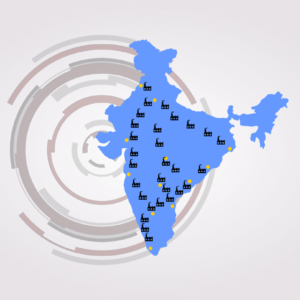
The Global Innovation Index (GII), published by the World Intellectual Property Organization (WIPO), takes the pulse of the most recent global innovation trends. It ranks the innovation ecosystem performance of economies around the globe each year while highlighting innovation strengths and weaknesses and particular gaps in innovation metrics.
Since its inception in 2007, the GII has shaped the innovation measurement agenda and become a cornerstone of economic policy making, with an increasing number of governments systematically analyzing their annual GII results and designing policy responses to improve their performance.
Published annually, the core of the GII provides performance measures and ranks 132 economies on their innovation ecosystems. The Index is built on a rich data-set – the collection of 81 indicators from international public and private sources.
The GII 2021 was the 14th Edition of GII and here we will take a review of India’s position in the same.
India ranks 46th among the 132 economies featured in the GII 2021. In 2020 GII it was 48th. Hence, India is amongst the top 50 most innovative countries in the World. For the last ten years, it has continued to retain its position as the most innovative country in Central and South Asia. India ranks 2nd in the Lower middle income group. India, among other few developing economies hold the record for over performing on innovation relative to their level of development for the 11th year in a row.
The GII has two sub-indices: the Innovation Input Sub-Index and the Innovation Output Sub-Index, and seven pillars, each consisting of three sub-pillars.
Let us have a look at how India fared on various pillars of GII 2021:
A] Institutions:
India produces more innovation outputs relative to its level of innovation investments as its input rank was 57 and output rank was 45. India was ranked 62nd as far as Institutions were concerned. The factors considered were political, regulatory and business environment.
B] Human Capital and Research:
India ranked 54th on this pillar. The sub pillars consisted of Education, Tertiary Education and Research and Development. It has been observed that India’s Gross expenditure on R&D was 0.7% of GDP.
C] Infrastructure:
India ranked 81st in this pillar. The sub pillar are Information and Communications Technologies (ICT), General Infrastructure and Ecological sustainability. It is important to know the lower ranking as far as Electricity out put is concerned (94th).
D] Market Sophistication:
India ranked 28th in Market Sophistication. The sub pillars consisted of Credit, Investment and Trade, Diversification and Market scale.
E] Business Sophistication:
The ranking on this pillar was 52nd. The sub pillars are Knowledge workers, Innovation linkages and Knowledge absorption. The ranking for innovation linkages was 50th.
F] Knowledge and Technology Outputs:
India ranked 29th on this pillar. The subs included Knowledge creation, Knowledge impact and Knowledge diffusion. India ranked 1st in ICT services exports as a percentage of total trade.
G] Creative Outputs:
The rank on this criterion was 68th. The sub pillars were Intangible assets, Creative Goods and Services and Online Creativity.
Overview of the strengths and weaknesses of India in the GII 2021 (with ranking)
Strengths
- Graduates in science and engineering as percentage of total grads. (12).
- Global corporate R&D investors, top 3, mn US$ (15)
- QS university ranking, top 3 (23)
- Ease of protecting minority investors (13)
- Trade, diversification, and market scale (7)
- Domestic industry diversification (12)
- Domestic market scale, bn PPP$ (3)
- Citable documents H-index (21)
- Labor productivity growth, % (17)
- Knowledge diffusion (13)
- ICT services exports, % total trade (1)
- Cultural and creative services exports, % total trade (18)
Weaknesses
- School life expectancy in years (95)
- Pupil-teacher ratio, secondary Education (99)
- Tertiary inbound mobility, % (108)
- ICT access (111)
- ICT use (110)
- Environmental performance (125)
- Females employed with advanced degrees as % (103)
- New businesses/th pop. 15–64 age (115)
- Entertainment and media market/th pop. 15–69 age (59)
- Printing and other media, % manufacturing (83)
- Wikipedia edits/mn pop. 15–69 age (117)





